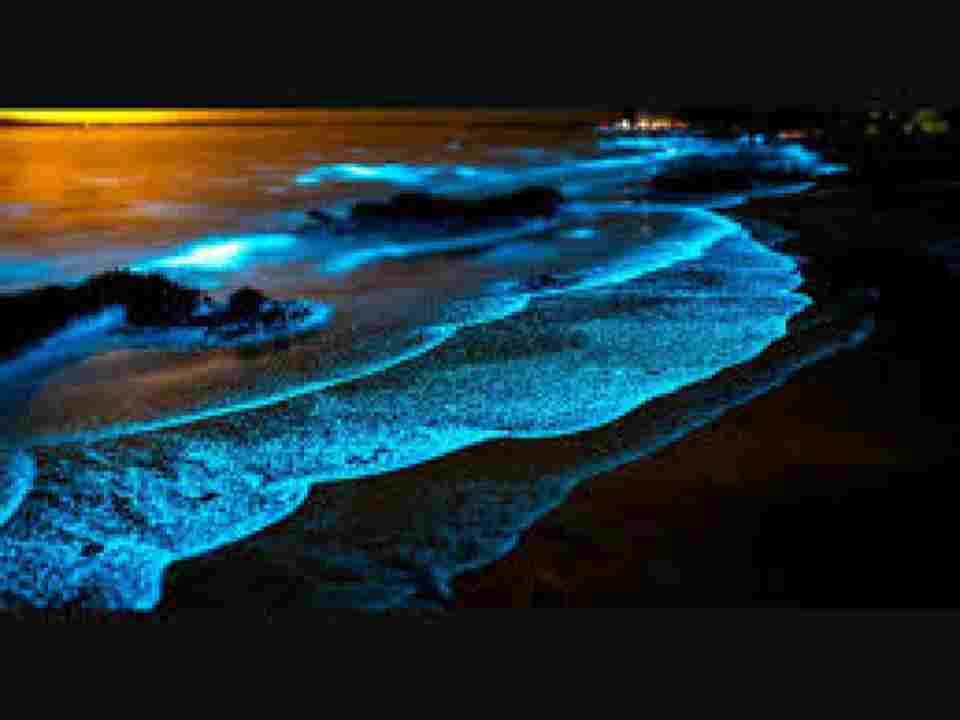Description
The recent appearance of glowing blue waves in the backwaters of Kochi, Kerala, has captured the fascination of tourists and nature enthusiasts. However, while the bioluminescent spectacle is visually stunning, it has sparked serious concerns among ecologists and local fishing communities due to its environmental implications.
Understanding Bioluminescence
Bioluminescence is the emission of light by living organisms, often triggered by movement or disturbance in water. It is commonly caused by microorganisms such as Noctiluca scintillans, a species of dinoflagellate plankton popularly known as "sea sparkle." These tiny plankton emit light through a chemical reaction within specialized cells called scintillons.
Though typically blue, the glow may appear red or brown depending on the density and species of plankton involved. In Kerala, this phenomenon is often witnessed between March and May and is locally referred to as "Kavaru."
Scientific Factors Behind Glow
The surge in bioluminescent activity is closely tied to environmental factors. A key driver is eutrophication, the excessive enrichment of water bodies with nutrients like nitrates and phosphates—mainly due to untreated sewage, agricultural runoff, and industrial waste. These conditions, coupled with specific temperature ranges, high salinity (30–35 ppt), and limited rainfall, create a favorable environment for rapid plankton growth.
When these organisms multiply beyond 500,000 per liter, it can lead to red tides, a form of harmful algal bloom (HAB) that disrupts marine ecosystems.
Environmental And Economic Consequences
While plankton are essential to the marine food chain, overpopulation can have devastating effects. Dense blooms release compounds such as dimethyl sulphide, ammonium, and dissolved organic carbon, leading to oxygen-depleted (hypoxic) zones. This lack of oxygen often results in the mass death of marine organisms, severely affecting biodiversity and aquaculture.
Local fishing communities suffer direct economic setbacks as fish either die or migrate away from bloom-affected areas, leading to reduced catches and lost income.
Some species involved in these blooms also produce toxins like domoic acid and compounds from the Alexandrium genus, which can cause serious health issues such as amnesic or paralytic shellfish poisoning in humans who consume contaminated seafood.
Welcome to Notopedia.com, your free learning platform that caters to the diverse needs of students and aspirants across a spectrum of entrance exams and educational endeavors. Whether you're preparing for highly anticipated exams like CAT, NEET, JEE Main, or bank job vacancies, our platform offers a wealth of resources to guide you towards success. Stay up-to-date with the latest exam dates, announcements, and results for various government recruitment exams, including SSC CGL, CHSL, NDA, and UPSC. Explore comprehensive study materials, sample papers, and exam patterns to hone your skills and boost your confidence. From important dates like CBSE Class 10 and 12 date sheets to exam-specific information like JEE Main application form date, we cover it all. Notopedia.com is your go-to source for everything from admissions and admit cards to scholarships and college information. Whether you're aiming for a career in defense, government, banking, or higher education, our free learning platform equips you with the knowledge and resources you need to excel. Join us in your educational journey and unlock a world of opportunities, guidance, and comprehensive support.
For more Updates and Information - Visit Notopedia's Bulletin Board
For Latest Sarkari Jobs - Visit Notopedia's Sarkari Jobs Section
For access to more than 20,000 Colleges - Visit Notopedia's College Section
For School Studies and Exams Preparation across 14 Boards - Visit Notopedia's School Section
For Comprehensive Preparation of Sarkari Job Exams - Visit Notopedia's Sarkari Exams Section










